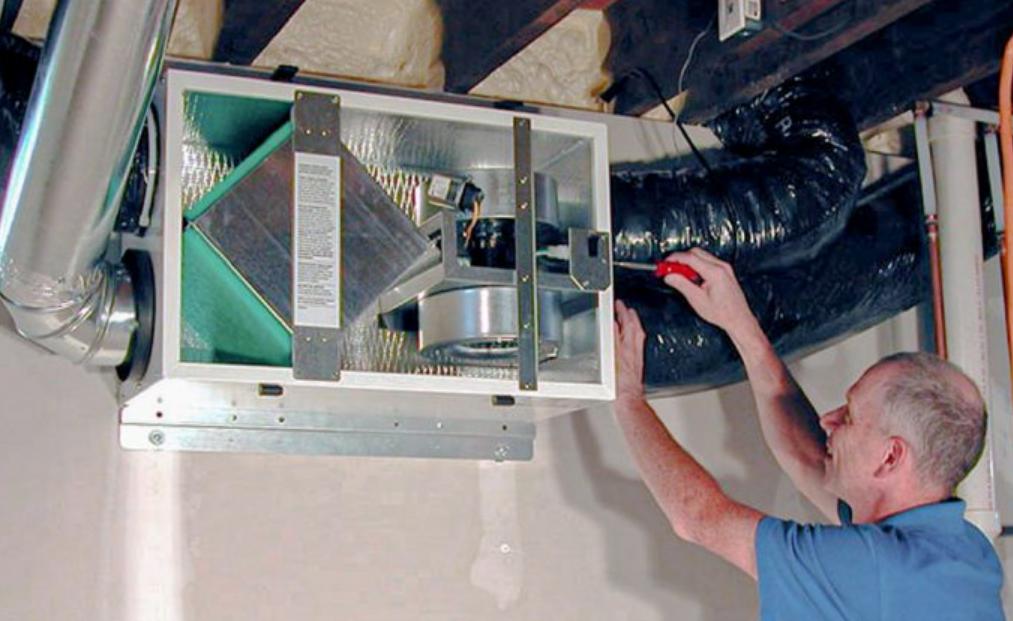Never has indoor air quality been more important. And houses, built to be more energy-efficient and airtight, often restrict natural airflow. All of this can cause air to get stale and contribute to pollution and discomfort. Meet the Energy Recovery Ventilator (ERV) – the latest technology in balancing ventilation and energy loss. If you have been asking how can I improve the quality of air in my home without sacrificing energy efficiency – you guessed it, this article is for you!
Thank you for reading this post, don't forget to subscribe!By the time you’re done, you’ll understand how ERVs work, the benefits they offer, how they stack up to HRVs, and how to pick the perfect system for your house.
What’s an ERV and Why Should You Care?
An energy recovery ventilator (ERV) is a type of mechanical equipment that features a cross-flow heat exchanger that transfers energy from the exhaust air of a building to the supply air entering the building. Whereas unsophisticated ventilation can also leave you with hefty heating or cooling bills, ERVs maintain the temperature and humidity levels of your home.
It’s the difference between the comfort of clean, fresh air, and the stale, stuffy air in your home. Insufficient ventilation can give rise to allergies, respiratory problems, and mold. ERM ensure fresh, pure air is exchanged — in all seasons — reducing utility bills.
How Does an ERV Work?
The mechanics of an ERV might seem complex, but its operation is remarkably straightforward.
An ERV works by transferring heat and humidity to and from the outgoing and incoming airstreams. Here’s how it would work, step by step:
- The aircraft’s operation removes stagnant indoor air from bathrooms, kitchens and living areas.
- At the same time, fresh outdoor air is pulled into your home.
- An ERV contains a heat exchanger that exchanges heat and moisture between two airstreams; exhaust air (outgoing) and supply air (incoming). This minimizes energy losses.
- The result is filtered, temperature-controlled and more comfortable air coming into the home with less drastic temperature changes that a regular ventilation system could produce.
- ERVs take advantage of this heat and water exchange, providing get ventilation with out losing efficiency or comfort.
The Advantages of Adding an ERV to Your Home
Why should I install an ERV in my home? Here are key advantages:
Improved Air Quality
Fresher air: ERVs expel contaminants, allergens and moisture out of indoor air while constantly drawing fresh air in. This is particularly useful for those who suffer from asthma or allergies.
Energy Efficiency
Unlike conventional ventilation, ERVs are more energy efficient because they can exchange the heat between incoming and outgoing air. This is a reduced heating and cooling load, which in turn yields lower utility bills.
Moisture Control
ERVs also ensure that the inside of your home has the ideal humidity. They cut down not only on excess moisture (which can cause mold) but also on overly dry winter air.
Environmental Responsibility
Because they use less energy and produce fewer emissions, ERVs are an environmentally responsible option for homeowners.
Enhanced Comfort
There is no need for ERVs to be affected by outside temperature changes, as an ERV will blunt those changes by equalizing the temperature of the incoming fresh air.

ERV vs HRV: What’s the Difference?
Many home or business owners mistake ERVs for HRVs (Heat Recovery Ventilator). Despite that they both enhance air quality as well as energy efficiency, they do have a slightly different function.
HRV (Heat Recovery Ventilators):
As an initial approximation let us pay all the attention to the heat exchange between outgoing and incoming air, and pay no attention to the moisture.
- Perfect for cold dry conditions and best for the consumer not concerned with excess moisture management.
- Energy Recovery Ventilators (ERVs): About They work on a similar principle to HRVs.
- Conduct heat and moisture, equalize humidity.
- OK for high-humidity climates or humid seasons.
- Don’t overlook your local climate and your own home’s specific needs when choosing between the two.
Points to Consider While Selecting an ERV System
Before you invest in an ERV, there is no one-size-fits-all answer. Weigh these considerations to determine which system is best for your home:
Size and Capacity
Select a system that suits your home’s square footage and ventilation requirements. Too small of a unit won’t effectively filter the air and too large can cause inefficiencies.
Climate
If you’re in a humid climate, an ERV is the way to handle moisture. In cooler, dryer climates, an HRV may be adequate.
Noise Level
If a serene home environment in your top priority, seek models with quieter operation.
Energy Efficiency Ratings
Make sure the unit you choose is energy certified for long-term savings.
Filtration
Choose an ERV system with good quality filters for allergens, dust, etc. You can’t go wrong with a HEPA filter, or ones rated CBC or that have MERV ratings of 12+.
Budget
There is an ERV for every budget. Take into account your initial costs and longer-term savings while in your system.
Additional Features
Certain systems also provide intelligent controls, remote monitoring capabilities and air purifying technology. It has extras options that will add value, but might up the cost upfront.
Professional Recommendations For Installation and Maintenance
Why You Should Have Your Awning Professionally Installed
Proper installation is important if you want your ERV to work effectively. With an HVAC professional inspecting your home’s ventilation layout, they can determine where the system needs to be installed and which type of ductwork would work best.
Maintenance Must-Haves
Protect your investment in your ERV by maintaining it regularly once installed:
Filter Cleaning/Replacement: Change filters every 3-6 months to keep the air clean.
Examination of Heat Exchanger: Clean heat exchanger once a year to prevent restrictions in air flow.
Control Settings Verify: Change or program settings for months of efficiency.
Getting your ERV professionally checked annually will also maximize life and performance.
Breathe Easier and Live Unfettered with An ERV
Placing an ERV in your home is affording yourself the luxury of better health and comfort while reducing your carbon footprint. An ERV also helps to create a healthier home environment for you and your family with improved indoor air quality, while at the same time conserving energy.
Not sure where to start? Ask a nearby HVAC expert or contact us for tailored advice. Start living cleaner and healthier today!



